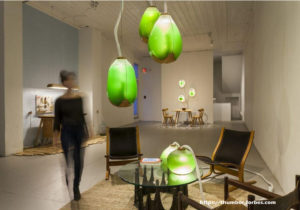There are many claims from furniture manufacturers and retailers about the furniture on display at their showroom or website-about durability, comfort, value, and even about environmental friendliness or “green” qualities.

Some considerations to think about when shopping for eco-friendly furniture, discussed here, will help you qualify what the terms really mean and what things are important and which are “puffery”.
Furniture and furnishings are the third largest user of wood and wood products, after building and paper, and there is a high transport cost of wood. So, if imported (from Asia especially), wood products will have a high “carbon footprint” for furniture sold in the US. However, there are some choices that you can make as a consumer, and a big one is the source of the lumber used.
In wood furniture and in the wood frames of upholstered furniture-there are two certifying organizations that the manufacturer will tout if they used certified sources. The most stringent is “FSC” (Forestry Stewardship Council) and is used mostly for export lumber and by European lumber suppliers. The same is true for PEFC (Programme for Endorsement of Forest Certification). Many domestic (US) lumber mills are smaller and only sell to domestic users and so adhere to and are certified by the SFI (Sustainable Forestry Initiative) which is less stringent, but still require much more environmentally friendly practices than non-certified sources. The last audit of certified timberland in 2006 showed that less than 16% of US forestland is sustainably certified and virtually no Asian forests are sustainably managed.
The use of fiberboard, particle board and plywood in furniture does save on the amount of lumber that has to be harvested to make the product, and has less lumber waste associated with its manufacture. However, these products may include toxic adhesive components. Many countries are introducing more stringent requirements on the chemicals that can be used in adhesives, but there are still many countries who do not have any restrictions and enforcement of the US regulations is difficult and spotty.
Furniture also uses almost 1/3 of the polyurethane foam that is made worldwide, and it is wholly petrochemical based. Some upholstery manufacturers are now using “bio-foam” which has some level of soy-based foam as a component. Complete soy foam does not yet have the durability and resilience needed, but the foam manufacturers are working to increase that percentage and make progress each year. The automobile companies have been in the forefront of requiring recylcability for their products and the foam used in car seating has helped the process for furniture manufacturers who are willing to pay the premium for bio-foam. The other eco-friendly alternatives are down and natural latex, and are most often found in custom upholstery.
Fabrics used in furniture also have an eco-friendly component available as well. Certified organic textiles such as cotton are grown with no pesticides and herbicides, but still require a great deal of water to sustain the long growing cycle and requires a more limited climate to thrive. Nonetheless, cotton accounts for more than 90% of the “natural fiber” market.
Some alternatives to cotton that are eco-friendly are linen, bamboo, hemp, abaca, wool and silk. The plant fibers are all “rapid renewal” grasses and have much shorter growing seasons and wider climate ranges than cotton. The drawbacks to some, like bamboo, is that harsh chemicals are required to release the fibers. Linen (flax) and hemp have been used for ages for fabric and so have more environmentally friendly methods of fiber release for weaving.
None of the eco-friendly choices are black and white; there are land use conversion issues with materials like bamboo and even wool, where forests are cleared for plantations or pastures. Deforestation is an issue with lumber harvesting and the renewal process. Sustainably managed forests can take decades to renew, and some forests are replanted with only one species, so bio-diversity is affected.
Hopefully some of this information will help you become a more knowledgeable consumer and the choices and trade-offs can be made with conscious thought, rather than with little understanding of the complexities involved.














